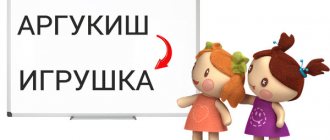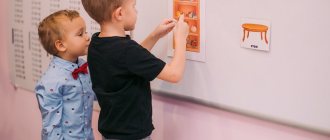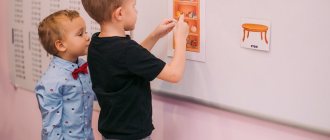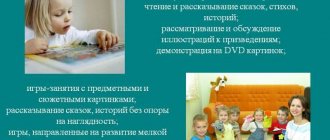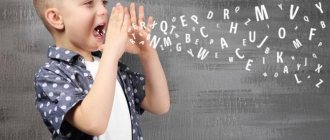A child's transition to school is a rather complex process. At this moment, memory, thinking, and attention are rebuilt. Insufficiently developed attention among schoolchildren today is considered a real problem and causes concern on the part of parents and teachers.
Attention plays an important role in the learning process. Attention is the concentration of the subject’s consciousness on a specific object. It is thanks to him that children can assimilate the necessary information, eliminating the unimportant. Younger schoolchildren have not yet learned to concentrate attention on a specific object for a long time. Therefore, distraction, inattention, a small amount of attention and the lack of ability to distribute it between other subjects are a typical age-related feature of younger schoolchildren. This can cause absent-mindedness, forgetfulness, and failure at school. The student himself suffers due to his inattention, as it is difficult for him to perceive information and assimilate it, due to his inability to concentrate. Responsibility for developing a child’s attention falls on the shoulders of not only teachers, but also parents.
Attention is of the following types:
- involuntary (appears spontaneously, without effort);
- voluntary (conscious concentration on an object, requiring volitional efforts);
- post-voluntary (purposeful concentration on an object without much volitional effort).
Types of attention
Attention is the selective focus of perception on certain objects. This is a special condition in which a child or adult is able to focus cognitive processes on specific objects.
There are different classifications of attention. The most traditional of them is based on arbitrariness:
- Involuntary attention. It does not require any effort from the object, but is attracted by a strong stimulus. The main function is instant orientation in constantly changing environmental conditions. This type of attention is also called emotional or passive.
- Voluntary attention. It is characteristic only of humans and is characterized by volitional efforts. This type is called active or volitional attention. It occurs in situations when a person sets himself a certain task and consciously works out an algorithm of actions for this purpose. The main function is the active regulation of mental processes. Voluntary attention is closely related to will.
- Post-voluntary attention. It is found in situations when a person forgets about everything and immerses himself in work. Volitional orientation is combined with favorable operating conditions. Attention is associated with a conscious goal and is supported by conscious interest.
How to effectively develop attention in younger schoolchildren
Younger schoolchildren have predominantly developed involuntary attention, so they tend to be often distracted. At the same time, their stability of voluntary attention is short-term. For children aged 7-8 years, it is typical to maintain voluntary attention for no more than 15 minutes. Pupils of the first and second grades do not yet have the ability to concentrate on work for a long time, especially if it is monotonous and does not arouse any interest in them, so children are easily distracted.
Children of primary school age should be able to concentrate on a learning task, maintain concentrated attention on it for a long time, and quickly and flexibly switch from one task to another.
Attention can be classified according to the following parameters:
- volume (concentration on several objects at once and keeping them in mind);
- stability (retention of information about a subject for a long period);
- concentration (retention of information about an object in short-term memory);
- selectivity (concentration of attention on the desired object);
- distribution (performing several actions simultaneously, without errors);
- switchability (switching attention from one subject to another);
- voluntariness (concentration of attention on demand).
The properties of attention begin to develop in children during preschool age. But when you go to school, development does not stop there; on the contrary, it requires even more constant systematic training. Parents should carefully monitor the development of all of the above properties of attention, since violation of each of them leads to disruption of the child’s activity and behavior.
This article contains exercises for children to concentrate attention and its basic properties.
Interesting exercises
To develop the attentiveness of a child 8-10 years old, you can also use special exercises.
- Description from the memory of the main character of a fairy tale that was recently read.
- Finding all the differences in two similar pictures. For school age, bright drawings with an abundance of small details are needed. The child learns to concentrate on several things at the same time.
- Reading words backwards. It would seem like a primitive activity, but it is an excellent trainer for visual memory.
- Solving crossword puzzles. The child begins to show more perseverance. By solving entertaining tasks, the baby trains his memory. The brain is tuned to the future solution of more complex problems.
- Exercise "Find the color." The point is to correctly name the colors in which the words are written. The child focuses on the color of the code, not the word. The whole difficulty is that they do not correspond to each other. For example, the word “green” is written in red, “purple” is written in black.
- In general, lists of letters or numbers need to be found only for certain ones. You can use Schulte tables. Looking at them, the child must find all the numbers in order, while switching his attention as quickly as possible.
- Repeat exercises for adults.
- Word game. An adult names a word on a specific topic. The child repeats it and adds his own. This is how a long verbal chain is gradually built up. The players' task is not to break it off for as long as possible. For example: apple-banana-grapes-orange... (theme “Fruits”).
- Drawing by cells. The child is asked to draw a figure according to the model. It can consist of both open and closed figures. During the exercise, not only concentration of attention develops, but also fine motor skills.
Motor games for attention
Then you can move on to outdoor games. Elements of them are sometimes performed in physical education lessons. In the process, you need to execute several sequential commands - one after another. Gradually, some new details are introduced - a third is inserted between two actions, then a fourth, until several simple actions become an algorithm for complex ones.
For example, “Mirror” develops not only attention, but also coordination.
Task 1: You can play together or in a group. A presenter is selected. He shows different grimaces and movements, the second player (team), as if in a mirror, everyone repeats him. Not only the movements must be precise, but also the tempo, speed and rhythm. If you make a mistake, you lose and you become the leader.
Task 2: the layout is the same - the players and the presenter, it shows simple movements - the players do everything in reverse. For example, turns to the right - players turn to the left, crouches - players jump, leans to one side - players to the other, etc.
Task 3: the leader performs actions that imitate something specific, for example, digging, washing windows, screwing in a lamp, etc. After a few seconds, the group mirrors his movements, and then guesses what it was.
Another active game for attention is “Dark Labyrinth”. It is necessary to choose a leader, everyone else lines up in one line and closes their eyes. Next, the leader begins to command: step to the right - 3 steps to the left - 5 steps forward - 2 back - turn to the right - turn 180°, etc. At the leader’s command “stop”, everyone opens their eyes and if someone is in the wrong place, where is everyone, he leaves the game.
Toys to develop attention
An educational toy is a toy aimed at developing mental abilities. Often parents want to pay attention to the development of their child so much that they are ready to use the latest techniques for this and seek help from expensive educational centers.
However, the wheel does not always need to be reinvented: what is at hand will bring a lot of benefit. Board games are a great way to develop attention. Play classic chess, checkers or lotto with the whole family.
By the age of eight, it becomes interesting to play strategy games. You can feel like a spy or become a real detective. Age-appropriate puzzles are good for developing attention. You can buy books with sound design.
Puzzles will help you focus on creating the final picture.
At 8-9 years old, children actively imitate adults. Many people start creating toys on their own - wooden cars or rag dolls. Children are attracted to complex construction sets with a large set of parts.
On attention and logical thinking
Figures numbers and attention
In a simple version, games for the development of logical thinking are also games with pictures. Only they are a little more complicated. Such exercises are often suggested to be performed in mathematics lessons.
The child is presented with a picture consisting of several cells. As a rule, no more than 9. Each line has three different geometric shapes. There are only two of them in one line, and the child is asked to find the missing figure.
For example: in one line there is a rhombus, a triangle and a circle. The second contains a triangle, a rhombus and a circle. In the third there is only a triangle and a circle. The child must realize that the missing figure is a rhombus.
In other options, the figures are suggested to be painted. Moreover, the sequence of colors also has its own logic - either the figures have only one color intended for them, or you need to paint the figure with the missing color.
Older children can be asked to do simple exercises on adding and subtracting numbers, or try to decipher a tricky code. When certain letters are hidden behind numbers. Use a code to read a few words.
Attention, words and concepts
If the child is not very keen on mathematics, then you can simply play with words. You need to name several words united by something in common - for example: sparrow, crow, tit - birds. Apple, pear, peach are fruits. To them you need to add a word that stands out from the general group. For example, add a ball to birds, and bread to fruits. And ask the child to find the extra one.
In the same way, from several things known and obvious to the child, ask him to find the strange and unusual. For example: a kitten meows, a duckling quacks, a crow barks. What's wrong? This same exercise can be classified as developing auditory attention.
What you need to know about the physiology of memory? What is the difference between memory before 3 years and after?
Yes, it's all about physiology. Remember? Until the age of 3, the child was so inquisitive, everything was interesting to him, he could remember a huge poem, even a poem, and read it with pleasure.
And how he composed it! Where does all this disappear with age?
Until the age of 3, a child’s memory is compared to a sponge that absorbs everything. There is an accumulation of knowledge and impressions by all systems of the body.
During this period, a child uses completely different parts of the brain for memorization than adults; he has a completely different potential.
His brain contains a huge number of connections for all occasions, which later disappear in an adult. This loss is up to 75% in some brain nuclei. This, of course, does not make us mentally retarded)
A child under 3 years of age has connections between different areas of the cerebral cortex. This is how auditory and visual memory work in unison and complement each other.
This is ensured by connections between the visual and auditory cortex. Any sound can give rise to color, and color can turn into sound. This phenomenon is called synesthesia.
Experiment with genius people
An experiment was conducted in England where people with phenomenal memory were studied. So, it turned out that a very large part of the 52 people have synesthesia.
The ability to “hear” color or, for example, they hear sound and at the same time there is an association with letters, and the smell gives rise to tactile sensations.
The brain of children under 3 years old is initially configured in the same way; it is universal and can do a lot. And, of course, it's important to use this time to strengthen amazing connections.
What needs to be done from birth in order not to miss time, read our article Makoto Shichida’s Method for Children. How can busy mothers do it anyway? (Link will open in a new window).
What happens next?
Unnecessary neurons that were not included in strong connections gradually die off as unnecessary. After 3-4 years with a child who has not been specially trained, it is difficult to learn a simple quatrain, versus a whole poem up to 3 years.
Completely different brain structures become responsible for memory. Children's memory is activated for the unexpected, new, interesting; the brighter for them, the better.
These are features of the development of memory at this age - it is involuntary.
But as the child’s brain continues to develop, the brain structures responsible for memory in a child from 4 to 5 years old will not be decisive for assessing his memory in the future.
Only by the age of 6-7 years does the memory of the cerebral cortex begin to develop, voluntary memory, which the child will use in the future.
Voluntary memory is when a child uses volitional effort or will to remember.
It would be good if by this age you had already started working on memory development with him.
If your child is still a preschooler, then all recommendations for memory development are here: Development of memory and attention in preschool children - the best games and exercises (opens in a new tab) and
You will find 44 of the best games for attention and memory for children aged 4 to 6 years here (opens in a new tab).
But if this does not happen, do not be sad. It’s never too late to develop memory for a child, and for an adult too. But what should be done? Where to start, where to run?
Video training from the course: How to correctly complete Schulte Tables for developing attention
Subscribe and new useful exercises will always be at hand:
VKontakteInstagramZenFacebookTelegramYoutube
Search for numbers and letters
Try also to practice searching for letters. These exercises are great for developing peripheral vision and speed reading. You can read more about this exercise in the separate article Search for letters and in the article with the simulator Search for numbers and numbers.
Tag
Tag is a great way to exercise your brain! The game of tag is a square board divided into 16 equal square sections. You have 15 square dominoes at your disposal, numbered accordingly. The dominoes themselves are randomly mixed inside the box.
The essence of this game is to put the dominoes in order, namely to place the numbers one after another from top to bottom, from left to right, therefore, the empty square should be from the bottom to the right. The game will help you develop logical thinking and memory, because it is useful to remember various tricks and combinations. You will also be able to develop the ability to calculate moves ahead without making mistakes. Shall we play?
Train now
Train right now on this page, for free and without registration.
Anagrams
Start with anagrams, they will help develop such qualities as: attention, concentration, speed of thought, speed reading. In this game you have to choose 1 option out of 4, in which only those letters that are part of the given word are mixed. Each round a new word is given. Remember that time is limited! The faster you look for the answer, the more points you will get at the end of the game.
Schulte tables
The Schulte table is one of the most effective exercises for developing the brain, attention, concentration, and accelerating visual search. This exercise is also the most popular exercise for developing speed reading. Schulte tables usually consist of randomly placed numbers or letters. The number of cells in tables also varies and most often they are 5x5 elements in size.
Why does a child’s memory suddenly deteriorate in elementary school? What to do?
Why does the question arise: How to develop memory and attention in an 8-year-old child, exercises, are there any that are most effective?
Why do teachers at school begin to complain about inattention, and why does it become difficult for a child to remember a poem? And the child sees some material that has already been covered as if for the first time. Or, let’s say, he knows the rule, but cannot apply it. How can this be?
On the contrary, I would like him to spend less time on lessons, to remember quickly and a lot, and for a long time.
He enjoyed the fact that it was easy for him to study, that he could still do whatever his heart desired. And in high school, the volume of what needs to be learned and remembered increases.
What will happen later if you don’t work on memory and attentiveness now? After all, passing exams and entering the coveted university depends on the volume of what has been studied and correctly applied.
The content of the article:
1. What do you need to know about the physiology of memory? What is the difference between memory before 3 years and after? 2. 5 ways to improve the situation. How to develop memory and attention in an 8 year old child, exercises
- The easiest step
- The connection between memory and thinking and imagination. How does this benefit us?
- An easy way to develop auditory memory
- The scary truth about visual memory
- What else is important to do to improve a child’s memory?
3. How not to become a genius with the help of attention? 4. A knight's step or what will save creativity and phenomenal memory?
